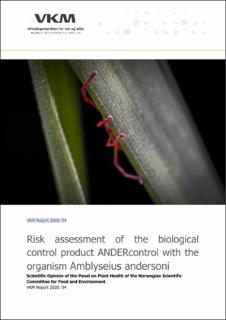| dc.description.abstract | ANDERcontrol with the predatory mite Amblyseius andersoni as the active organism is sought to be used as a biological control agent in Norway. ANDERcontrol is intended for use against different mites (such as the two-spotted, fruit-tree, and red spider mite, russet mite,cyclamen mite) and in horticultural crops such as fruits, berries, vegetables, and ornamental. VKM’s conclusions are as follows Prevalence, especially if the organism is found naturally in Norway: Amblyseius andersoni has not been observed in Norway. It has been observed, in low numbers, in southern Sweden and has the capability to enter diapause under unfavourable conditions which suggests the potential for establishing under Norwegian conditions. It is however, the view of VKM that it likely lacks the ability to survive and establish in areas with cold winters and chilly summers, as found in most parts of Norway under current climatic conditions. The potential of the organism for establishment and spread under Norwegian conditions specified for use in greenhouses and open field: The thermal preference of A. andersoni restricts its establishment, and the species has not been observed in Norway. The species is capable of entering diapause, but the lack of records, despite targeted surveys, makes it the opinion of VKM that it is unlikely that A. andersoni will be able to establish in outdoor areas in Norway. However, the lack of information on temperature tolerance of the species constitute an uncertainty factor. The risk of spread from greenhouses is low because no wind or vector are likely to carry the mites from the greenhouse to suitable outdoor habitats, and mite populations in greenhouses do not enter the more cold-tolerant diapause. All conclusions are uncertain due to lack of relevant information regarding the species’ climate tolerance. Any ambiguities regarding the taxonomy, which hampers risk assessment: There are no taxonomic challenges related to the assessment of A. andersoni. Assessment of the product and the organism with regard to possible health risk: VKM is unaware of reports where harm to humans by A. andersoni itself, or associated pathogenic organisms have been observed. Mites may however produce allergic reactions in sensitive individuals handling plant material with high numbers of individuals. There is reason to believe that this holds true also for A. andersoni. Key words: VKM, risk assessment, Norwegian Scientific Committee for Food and Environment, Norwegian Food Safety Authority, biological control, predatory mite | en_US |
